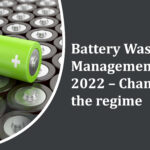The new Environment (Construction and Demolition) Waste Management Rules, 2025 is a pivotal shift towards sustainable waste management. This is effective from 1st April 2026 and will supersede the Construction and Demolition Waste Management Rules, 2016. Under the new Rule, the Ministry of Environment, Forest, and Climate Change (MoEFCC) has introduced provisions for Extended Producer Responsibility (EPR)[1], real-time tracking, mandatory recycling, and stringent penalties for non-compliance to curb environmental degradation and pollution by the waste generators[2] more effectively.
Construction and demolition waste[3] generation is a major concern for air, water and soil pollution, but the previous rules had failed to address the waste-related challenges effectively. The new rules require the producers[4] to take responsibility for their waste, pay penalties for violations, and report activities for monitoring through a central online portal established by the Ministry. It also mandates that the EPR targets in construction, reconstruction and demolition projects be regulated through a waste management plan[5].
The rules further define the responsibilities of waste generators (or producers), recyclers and other stake holders creating a strong vigilance mechanism. Waste generators are required to collect and segregate waste into separate material streams, store it safely, and ensure recycling or proper handover to authorized agencies or recyclers. They must also take necessary measures to prevent air pollution, avoid littering, and minimize public nuisance during waste collection, segregation and storage. Additionally, the rules stipulate that processed waste can be utilized in construction activities for projects with a built-up area of 20000 sq. meters or more, as well as for road construction.
A robust enforcement mechanism has also been introduced to monitor the activities of all the entities. The registration of the entities (i.e., Producer; Operator of Intermediate Waste Storage Facility; Recycler; and Collection point established by local or development authority) is a mandatory process now, and no one will be allowed to continue business without such registration. A centralized online portal has been introduced for this purpose which will facilitate registrations, filing of returns, and maintenance of a central data repository for tracking all related activities. A framework for waste utilization has also been prescribed under the Rules.
The specific provision (Rule 18) for compensation incorporated in this legislation has enhanced the stringency to comply with the newly introduced requirements. Rule 18 states that:
“Where any producer, operator of intermediate waste storage facility, recycler, occupiers of construction and reconstruction projects or any other entity, fails to comply with the provisions relating to disposal and recycling of construction and demolition waste in an environmentally sound manner, including extender producer responsibility target, utilization of waste target under these rules, thereby causing loss, damage or injury to environment or public health, it shall be liable to pay environmental compensation which may be equal to such loss, damage or injury under this rule.”
The MoEFCC’s Environment (Construction and Demolition) Waste Management Rules, 2025 represent an important leap forward in India’s environmental governance. By mandating real-time tracking, enforcing recycling of waste, and imposing stringent penalties for non-compliance, the government is laying the groundwork for a sustainable future. Stakeholders across the spectrum must collaborate to ensure the successful implementation of these rules, fostering a cleaner and greener India.
[1] “Extended Producer Responsibility or EPR” means the responsibility of a producer to manage construction and demolition waste and to meet recycling targets as per First Schedule to ensure its environmentally sound management.
[2] “Waste Generator” means an occupier of the project having full control over the construction or reconstruction or demolition or renovation or remodeling activity resulting in the generation of waste.
[3] “Construction and Demolition Waste” means the waste generated due to construction, demolition, remodeling, renovation, repair, and maintenance activities, and comprises of soil, sand and gravel, bricks and masonry, concrete, metal, wood, plastic, ceramic and such other items.
[4] “Producer” means a waste generator, who is occupier or in charge of a building or building complex project having a built-up area of 20000 square meters and above.
[5] “Waste Management Plan” means a document prepared by producers, duly approved by local authority, for the management of construction and demolition waste to meet extended producer responsibility targets under First Schedule I.
Written by: Aiswarya Dutta
Co-authored by: Amiya Mukherjee
Disclaimer
This content is intended for informational purposes only and does not constitute a legal opinion. Despite our efforts to maintain accuracy, we do not make representations, warranties or undertakings regarding the quality, completeness or reliability of the content. Readers are encouraged to seek legal counsel prior to acting upon any of the information provided herein. This content, including the design, text, graphics, their selection and arrangement, is Copyright 2024, Lexplosion Solutions Private Limited or its licensors. ALL RIGHTS RESERVED, and all moral rights are asserted and reserved.
For any clarifications, please reach out to us at 91-33-40618083 or inquiries@lexplosion.in. Refer to our privacy policy by clicking here.




